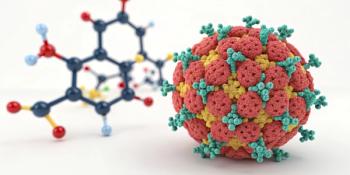
Much Ado About MET for Precision Medicine in NSCLC, Review Finds
FDA has recently approved therapies targeting MET exon 14 skipping mutations.
Recent declines in lung cancer death rates have everything to do with better treatments for the more common disease type, non-small cell lung cancer (NSCLC), which accounts for
Profiling of epidermal growth factor receptor (EGFR), anaplastic lymphoma kinase (ALK), c-ros oncogene 1 (ROS1) and BRAF has been common for some time. More recently, MET exon 14 skipping mutations, which are the newer targets on the block, have become important, according to a
Authors of the Translational Lung Cancer review report that MET exon 14 skipping is seen in about 3% to 4% of NSCLC cases, both squamous and adenocarcinoma; other estimates put the share of cases as high as 5%. The MET exon 14 skipping mutation is especially important as researchers seek treatments for NSCLC among patients who have never smoked;
Despite the identification of MET, early trials that focused on unselected MET were not fruitful; it was the recent shift to MET exon 14 alterations and MET amplification that has produced meaningful clinical responses.
FDA has approved selective MET inhibitors to target these mutations, including twice-daily Tabrecta (
“Results from these trials are eagerly awaited to definitively establish the role and setting for use of these agents in NSCLC patients,” write authors led by Mariacarmela Santarpia of the University of Messina.
The authors reviewed papers published through September 2020, including abstracts presented at major international cancer meetings and data from completed and ongoing clinical trials. In their review, the authors discuss the complexity of MET, its location and structure, its relationship with the receptor tyrosine kinase family, and its ability to recognize the hepatocyte growth factor (HGF). MET expression has many factors and layers, and MET in turn “activates multiple signal transduction pathways,” including several already well known in cell proliferation, movement, and survival.
A key feature of MET is its ubiquity: the authors explain how MET is expressed across a range of cells, from cells that make up the lining of organs to those than form the inner layer of blood vessels, to neurons, to liver cells, to cells that form blood cells. Thus, they wrote, MET is involved in multiple physiological processes, from embryonic development to tissue repair.
Therapeutic interest in MET stems from the way it propels cancer both directly and indirectly. In NSCLC, MET is both a primary oncogene, and it can serve as a secondary driver leading to resistance to targeted therapy in cancer fueled by other oncogenes. As
At the same time, the authors write, MET also serves as a biomarker, telling physicians that many common drivers are likely not present, while others could be working alongside MET to fuel the tumor.
“Of note, similar to other activated oncogenes, MET exon 14 mutations have been shown to be mutually exclusive with other known drivers, including EGFR, KRAS, BRAF mutations and ALK or ROS1 rearrangements, but to co-occur with other alterations, such as MET, MDM2, CDK4 and EGFR amplification, and also with PI3KCA mutations,” they write.
Several MET-related proteins have been connected to lung cancer; new MET fusion proteins have been found through RNA sequencing analysis, and MET fusion partner genes have been identified in lung cancer through next-generation sequencing. “MET fusions are oncogenic in cellular models, suggesting may be suitable for targeted inhibition in lung cancer,” the authors write.
This knowledge has propelled clinical trials for agents targeting MET exon 14 mutations along with trials involving combinations. The authors discuss various individual agents against the HGF/MET axis and multitarget MET tyrosine kinase inhibitors.
“The role of MET gene or protein alterations in the development of resistance to EGFR TKIs in EGFR-mutant NSCLC has been well established and results from trials with combination of EGFR and MET TKIs are encouraging,” they write. “Other combination strategies, including MET TKIs and [immune checkpoint inhibitors], need to be further explored. Finally, although MET gene fusions are relatively rare, some data suggest they could represent promising predictive biomarkers for targeted therapies in lung cancer to be screened at baseline together with other more common driver alterations.”
Newsletter
Get the latest industry news, event updates, and more from Managed healthcare Executive.


















































